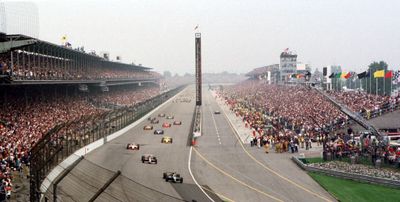Speedway fuels untold memories
Indy begins 3-year centennial festivity

INDIANAPOLIS – In 1958, a budding race-car driver named Mario Andretti first laid eyes on the Indianapolis Motor Speedway.
His family, which arrived from Italy three years earlier, had driven from their Pennsylvania home so that Andretti could watch the Indianapolis 500.
After the race, the 18-year-old made it to the infield to walk on the famed 2.5-mile track, which includes a narrow front straightaway lined with grandstands on both sides.
“It was very daunting,” said Andretti, now 69. “Just to look at all those grandstands, it was quite a sight, so unique.” At that moment, he said, “I wanted to find out what those other drivers were experiencing. It egged me on even more.”
Andretti went on to win the 500 in 1969 and become one of the most famous racers in history, also winning in Formula One in Monza and NASCAR in Daytona.
But it’s the Indianapolis Motor Speedway he considers the most hallowed ground, a track that’s launching a three-year centennial anniversary at this year’s Indy 500 on Sunday.
Since its founders built the track northwest of downtown Indianapolis in 1909, the speedway and the race – which was first held in 1911 – remain one of the sporting world’s most celebrated fixtures. For many fans, the Indianapolis Motor Speedway and the Indy 500 – like Churchill Downs and the Kentucky Derby, and the Augusta National Golf Club and the Masters – endure as unique institutions whose popularity surpasses that of their sports. However, the popularity of the speedway and the 500 has dipped from the 1960s-1990s, when Andretti, A.J. Foyt, Rick Mears and the Unsers made themselves household names. That was because of a civil war within the sport that badly bruised the fortunes of Indy car-style racing for more than a decade and, at the same time, NASCAR’s popularity soared.
Yet more than 200,000 people still squeeze into the Indianapolis speedway each year, drawn not only by the allure and danger of 33 drivers racing at more than 220 mph – including newer stars such as Danica Patrick – but by the race’s traditions: the prerace singing of “Back Home Again in Indiana,” the release of thousands of colored balloons, and the winner’s drink of milk in Victory Lane.
“The traditions are awesome,” said Dario Franchitti, who won the Indy 500 in 2007 and starts third Sunday. “I love the history of the place.”
Large gas-filled balloons, in fact, made up the first race at the speedway in 1909, followed by motorcycles and then cars in the 1911 Indy 500 won by Ray Harroun.
The track’s surface originally was made of crushed stone sprayed with tar, but too many accidents prompted organizers to lay 3.2 million paving bricks on top of that surface in late-1909. That led to the speedway’s nickname “The Brickyard.”
The speedway has a modern paved surface today, but a strip of the original bricks remains at the start/finish line.
Famed fighter pilot and former Indy 500 racer Eddie Rickenbacker led a group that bought the speedway in 1927 and later sold it in 1945 to the late Tony Hulman of Terre Haute, Ind. The family still owns the track, and his grandson, Anton Hulman “Tony” George, 49, is the speedway’s chief executive and an often controversial figure.
It was George who triggered the split in what was then the Championship Auto Racing Teams (CART) series in the mid-1990s because of concern that oval-track races such as the Indy 500 were losing their value within the series. He started a separate Indy Racing League that divided the sport’s participants, fans and sponsors for 12 years, until both sides finally reunited in 2008 under the IRL banner.
“There’s no question that the split we experienced hurt (the 500),” Andretti said. “All of a sudden the greatest stadium in the world didn’t have all the best players.”
George also helped bring other types of racing to the speedway. NASCAR arrived in 1994, and the Allstate 400 at the Brickyard remains one of NASCAR’s premier events. The track also hosted Formula One with the U.S. Grand Prix from 2000 to 2007. George also helped spearhead development of the SAFER barrier, which stands for Steel and Foam Energy Reduction, a type of wall that helps reduce injuries by better absorbing the impact of crashing cars. The walls are now used throughout racing.
And crashes, sometimes fatal ones, also are part of the speedway’s long history. The accidents in the 1960s and ’70s prompted the late Los Angeles Times sports columnist Jim Murray to pen such lines as “Gentleman, start your coffins!” and “This is the first time I have come 2,000 miles to cover a fire.”
Franchitti recalled sitting in the stands the first time he watched the Indy 500 in person, in 1997. “We watched (the cars) come out of Turn Four, they were dots on the horizon that come closer and closer and, boom, past they go, and you go, ‘Wow!’ Franchitti said. “I was just amazed at the size of the place.”
The track’s infield area alone is 253 acres, which the speedway notes would house the Rose Bowl, Yankee Stadium, the Wimbledon tennis complex, Churchill Downs and Vatican City with room to spare. But it’s not the size but the history of speedway and the 500, and their place the public’s consciousness, that makes them significant, Andretti said.
In his rookie year of 1965, Andretti became the youngest driver at the time to win the national championship. But when he appeared on “The Tonight Show” with Johnny Carson that year, Andretti was introduced only as the top rookie of the Indianapolis 500.
“At first I was so upset” that only the 500, and not the title, was mentioned, he said. “But after that, it drove something home to me. I realized what this race really means.”